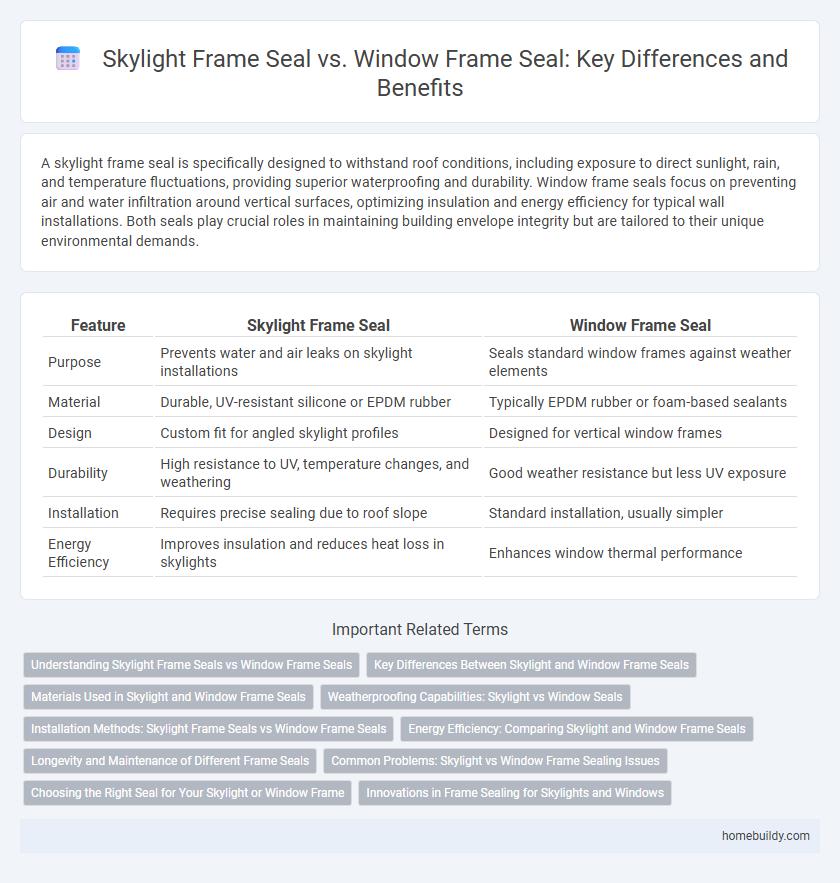A skylight frame seal is specifically designed to withstand roof conditions, including exposure to direct sunlight, rain, and temperature fluctuations, providing superior waterproofing and durability. Window frame seals focus on preventing air and water infiltration around vertical surfaces, optimizing insulation and energy efficiency for typical wall installations. Both seals play crucial roles in maintaining building envelope integrity but are tailored to their unique environmental demands.
Table of Comparison
| Feature | Skylight Frame Seal | Window Frame Seal |
|---|---|---|
| Purpose | Prevents water and air leaks on skylight installations | Seals standard window frames against weather elements |
| Material | Durable, UV-resistant silicone or EPDM rubber | Typically EPDM rubber or foam-based sealants |
| Design | Custom fit for angled skylight profiles | Designed for vertical window frames |
| Durability | High resistance to UV, temperature changes, and weathering | Good weather resistance but less UV exposure |
| Installation | Requires precise sealing due to roof slope | Standard installation, usually simpler |
| Energy Efficiency | Improves insulation and reduces heat loss in skylights | Enhances window thermal performance |
Understanding Skylight Frame Seals vs Window Frame Seals
Skylight frame seals differ from window frame seals primarily in their design to withstand harsher weather conditions and increased exposure to UV rays. Skylight seals are typically made from more durable, weather-resistant materials such as EPDM rubber or silicone to prevent leaks and maintain energy efficiency in sloped or overhead installations. Unlike standard window seals, skylight seals must also accommodate thermal expansion and contraction, ensuring long-term protection against moisture infiltration.
Key Differences Between Skylight and Window Frame Seals
Skylight frame seals are specifically designed to withstand intense UV exposure and extreme temperature fluctuations, ensuring long-lasting durability and preventing leaks from rooftop elements. Unlike typical window frame seals, skylight seals often feature multi-layer gasket systems that provide enhanced waterproofing and thermal insulation against rooftop rain and snow. Additionally, skylight seals must accommodate structural movement caused by roof expansion, requiring flexible materials that maintain airtight and watertight performance over time.
Materials Used in Skylight and Window Frame Seals
Skylight frame seals typically utilize materials such as EPDM rubber or silicone due to their excellent resistance to UV rays, extreme temperatures, and weathering, ensuring long-lasting durability and airtight performance. In contrast, window frame seals often incorporate materials like PVC or foam gaskets, which provide effective insulation but may degrade faster under prolonged sun exposure. The choice of seal material directly impacts the longevity and energy efficiency of skylight and window installations.
Weatherproofing Capabilities: Skylight vs Window Seals
Skylight frame seals provide enhanced weatherproofing capabilities compared to typical window frame seals due to their specialized design that accommodates roof pitch and prevents water infiltration from above. These seals often incorporate multi-layered gaskets and high-grade silicone materials to resist extreme weather conditions and UV exposure more effectively. Window frame seals primarily focus on vertical weather barriers, while skylight seals must address both vertical and horizontal elements, ensuring superior protection against leaks and drafts.
Installation Methods: Skylight Frame Seals vs Window Frame Seals
Skylight frame seals typically require precise fitting within angled or curved surfaces, using specialized adhesives and compression seals designed to accommodate roof pitch and weather exposure. Window frame seals, by contrast, are often installed on vertical surfaces with standardized rubber or foam gaskets that prioritize ease of replacement and airtightness. Installation of skylight seals demands expertise in roof membrane integration and thermal expansion considerations to ensure long-lasting waterproofing and insulation.
Energy Efficiency: Comparing Skylight and Window Frame Seals
Skylight frame seals are engineered to provide superior airtightness and thermal insulation compared to traditional window frame seals, significantly reducing heat loss and improving overall energy efficiency in buildings. Advanced materials used in skylight seals, such as EPDM rubber and high-performance gaskets, minimize air infiltration and moisture penetration, enhancing the thermal barrier and contributing to lower heating and cooling costs. This optimized sealing technology ensures that skylights maintain consistent indoor temperatures and reduce energy consumption more effectively than standard window frame seals.
Longevity and Maintenance of Different Frame Seals
Skylight frame seals typically use silicone or EPDM rubber, offering superior resistance to UV rays, temperature fluctuations, and moisture, which enhances their longevity compared to standard window frame seals made from vinyl or foam. These specialized seals require minimal maintenance due to their durability and flexibility, reducing the risk of leaks and deterioration over time. In contrast, window frame seals often need more frequent inspections and replacement to maintain their effectiveness against weather elements.
Common Problems: Skylight vs Window Frame Sealing Issues
Skylight frame seals often face challenges such as UV degradation and thermal expansion, leading to cracks and leaks that are less common in standard window frame seals. Window frame seals typically experience issues related to moisture infiltration and settling, resulting in draftiness and water damage. Effective skylight sealing requires materials resistant to weather extremes and flexible enough to accommodate roof movement, contrasting with the more stationary conditions of window frames.
Choosing the Right Seal for Your Skylight or Window Frame
Selecting the right seal for your skylight frame versus a standard window frame impacts energy efficiency and weather resistance significantly. Skylight frame seals must accommodate angled installation and UV exposure, often requiring flexible, durable materials like EPDM rubber or silicone to prevent leaks and heat loss. Window frame seals typically prioritize airtightness against wind and rain, using compression or weatherstripping seals designed for vertical surfaces.
Innovations in Frame Sealing for Skylights and Windows
Innovations in frame sealing for skylights prioritize enhanced weather resistance and energy efficiency by utilizing advanced gasket materials and multi-layer sealing technologies. Skylight frame seals often incorporate flexible, UV-resistant silicone compounds that accommodate thermal expansion and prevent water infiltration better than traditional window frame seals. These innovations lead to improved indoor comfort and reduced maintenance by minimizing air leaks and condensation risks in diverse climates.
Skylight frame seal vs window frame seal Infographic

 homebuildy.com
homebuildy.com